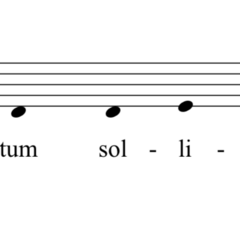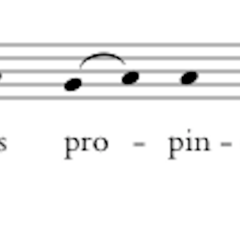Quid tantos iuvat
Two notations from eleventh-century England survive for this poem. The neumes added to a manuscript now held in Oxford (Bodleian Library, Auct. F. I. 15, hereafter OX) are the work of an experienced notator active at Exeter sometime between c. 1050 and 1072.[1] The notation added to a manuscript now in private ownership and previously held in Geneva (olim Bibliotheca Bodmeriana 175, hereafter GEN) cannot be securely attributed to a single centre or individual, although the manuscript has been tentatively associated with Canterbury.
1) Oxford, Bodleian Library Auct. F. I. 15, fol. 57v
Four of the twelve lines of the metrum were notated, implying a melodic division into three four-line strophes. Careful relative heighting, the frequent use of significative letters, and additional information provided by the closely related melody notated in GEN serve to guide transcription into modern notation.
A hint about the mode of the melody can be found at the very opening. In GEN, the second note of the two-note rise on the opening syllable is marked with an s indicating sursum or ‘high’. In strophic song repertories transmitted up to the twelfth century, an opening two-note rise with a raised second note is most common in melodies with a final of D. In the hymn repertory as edited by Bruno Stäblein, for example, there are at most a couple of examples of opening two-note leaps in melodies that begin on A, C, E, F and G, but twelve that begin on D (four of which rise by a fourth and eight of which leap a fifth).[2]
Assuming a D mode, the question is how to proceed. The most common leap to a high note at the beginning of a D-mode melody is from D to a. If this is assumed, then the indication iv (inferius valde or ‘truly lower’) at 1.3 can be observed within the mode leaping from an a at 1.2 to F at the beginning of 1.3. Pitches for the rest of the line may be suggested by following the implications of the relative heighting of the single-note signs (upright strokes) within a typical D-mode compass.

The indication h(umiliter) at 2.1 implies a lower note than the end of the previous line. Options are limited to either a C or an A given the prevailing D mode, with the former more likely since the melody proceeds to fall further as indicated by the relative heighting of the signs. The sign at 2.3 is initially confusing as it resembles a neume called the trigon and this is how it was described in my book of 2013. Three factors speak against this interpretation: i) the trigon is not found isolated on single syllables in the chant repertory, ii) it is not elsewhere found in notations for Boethian melodies, and iii) GEN has a single lower pitch at this point. A more probable reading is that the sign is a single lower pitch with the letters iu (iusum or ‘low’) written disjunctly above. In the context of the D-mode melody reconstructed to this point, this single low note is most likely a low A. Following the relative heighting of the signs and the e (meaning equaliter or ‘same pitch’) at 2.7, a realisation of line 2 may be suggested:

The beginning of line three features the indication e(qualiter), implying that the melody continues from the pitch reached at the end of line 2. One possibility for the remainder of the line would be to follow a minor third recitation formula, but two significative letters speak against such a reading. The first is at 3.3 in GEN, where the letter s appears. If a typical D-mode leap to the fifth degree is assumed, the relative heighting of the remaining neumes suggests a continuation that arrives at F as the final pitch of the line. At this point in the notation in OX, the indication m(ediocriter) appears, which would suit a realisation that ends on F as the mid-point between the first and fifth degrees.

There is no indication of pitch at the beginning of line 4, but two letters within the line serve to provide an orientation. The letter e appears before the upright single-note sign at 4.5, suggesting the same pitch as sung at 4.4. Given the overall contour outlined by the neumes from 4.1 through to 4.7, which remains unqualified by any indications as to notable height or depth, there are a limited number of possibilities for realisation within the modal framework: the highest pitch that might be reached at 4.7 is a, and the lowest pitch that might be reached at 4.3 is C. The presence of the letter s(ursum) at 4.4 in GEN further limits the available options; in order for the s to be warranted, a leap of some sort must be signalled. Two possibilities remain for the pitches at 4.3-5, either C-E-E or D-F-F. The latter solution is preferable since it results in a minor third recitation at syllables 4.1-4 and forms a seamless continuation from the end of the previous line.
[[{"fid":"2572","view_mode":"wysiwyg","fields":{"format":"wysiwyg","field_file_image_alt_text[und][0][value]":"OX QT4a","field_file_image_title_text[und][0][value]":false},"type":"media","field_deltas":{"4":{"format":"wysiwyg","field_file_image_alt_text[und][0][value]":"OX QT4a","field_file_image_title_text[und][0][value]":false}},"link_text":null,"attributes":{"alt":"OX QT4a","height":250,width="100%","class":"media-element file-wysiwyg","data-delta":"4"}}]]
Only the final seven syllables remain, for which certain assumptions may be made firstly on the understanding that the melody ends on the final, and secondly in the light of the indication i(nferius or iusum) that appears at 4.8. The first assumption when taken in conjunction with indications of pitch height conveyed by the neumes strongly implies that syllables 12-14 be read as C-D-D. How pitches might be assigned to syllables 8-11 is a more delicate question since there are multiple options with only a single letter to act as a guide. In order for the letter i to have an effect, a leap down must be assumed from syllable 7; if the pitch at syllable 9 is lower than the first note of the two-note rise at 4.8 (a similar relation in height obtains in GEN), then only three pitches are possible for the first note of this two-note rise: F, E or D. As for which pitch might be chosen and all the possible realisations that might follow from these pitches in accordance with the heighting indicated by the form and disposition of the neumes, the only guide is style.

The complete proposed reconstruction of the melody is therefore as follows:

2) Geneva, Bibliotheca Bodmeriana 175, fol. 82r

All twelve lines were notated by a single notator. Transcription into modern notation can be undertaken with some certainity due to the identity of the indicated profile with that recorded for the same metre in OX, where more detailed information about pitch height can be recovered from a greater number of significative letters. The relative heighting in the OX notation is also not interrupted by glosses; instances where glosses have disrupted the heighting of the neumes are indicated by square brackets above the neumes in the transcription from GEN.
The melodic reconstruction given here is based on GEN and thus extends across all twelve lines of the metrum. The melody accords with that reconstructed for the Oxford manuscript with only one significant departure: at the penultimate syllable of the second line, OX has a two-note fall (given as D-C), whereas GEN has a two-note rise (realized as E-F). It should also be noted that the s in GEN at 11.1 is misplaced: the direction sursum refers to the leap at 11.3 as correctly indicated in first strophe (3.3).
The reconstruction outlined above follows updates in certain particulars that given in Sam Barrett, The Melodic Tradition of Boethius’ De consolatione philosophiae in the Middle Ages, Kassel etc.: 2013, vol. II, nos. 61 and 74 .
[1] This is the principal Exeter music scribe, whose work is identified and described in Susan Rankin, ‘From memory to record: musical notations in manuscripts from Exeter’, Anglo-Saxon England 13 (1984), 97-112, esp. p. 111.
[2] Bruno Stäblein (ed.), Hymnen (I). Die mittelalterlichen Hymnenmelodien des Abendlandes, Monumenta monodica medii aevi 1, Kassel etc.: 1956. The relevant melodic openings are: A-D (P11), C-F (710, 761), E-a (737, 770), F-c (629), G-c (738), compared with D-G (727, 744, 759, P32) and D-a (146, 520, 545, 642, 726, 756, 767, P27).
